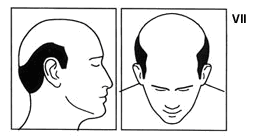

It is the most advanced state, where there is only inthe hair around the ears extending to the rear.
Both encasos more balding and very extensive baldness three sessions would be necessary. In some cases can adarse if the donor site is not sufficiently extensaparacubrirlaspartesdespobladas.
In these cases it is advisable not to opt for performing hair implants.

State or Grade VII
It is mainly characterized by the complete disappearance of the bridge that separates the two main areas of baldness. The depth of the front and crown areas increases and laterally towards the rear area.

State or Grade VI
State of normal hair, with minimal or no recession in the frontotemporal region and no shortage of hair on the crown. Lapérdida hair is normal regeneration.

State or Grade I
Classification of Baldness for Men
by: Norwood
Frontotemporal region presents small recessions, no larger than 2 cm, more or less symmetrically. Begins a slight hair loss and density thereof decreases in the front. This status allows Baldness ensure great results with a single session of microfollicular Follicular.

State or Grade II
It is the first degree of decline may be considered baldness, these states have different patterns: frontotemporal recessions without hair or thinning hair, and a variable frontal recession combined.
It comes complete with a localized hair loss at the crown, much more common with advancing age.
A single session of microfollicular Follicular will ensure satisfactory results.

State or Grade III
It is a more advanced degree of baldness, where the frontal and frontotemporal recession is deeper than in the State III, hair density in these areas is greatly reduced. The continuous frontal degeneration and advanced drop in the crown give way to a line of connection between the two most populated areas of the head, very characteristic of these states. For results should be between 1 and 2 sessions of microfollicular Follicular as desired hair density
State or Grade IV

In recent times we have tried to classify the stages of development of androgenic alopecia, both male comofemenina in order to individually set the level of the same in every person and unify medical criteria regarding best laterapia.
A mid-twentieth century studies of English Dr. James Hamilton established the first classification that bears his name on a scale of 8 degrees of alopecia. Subsequently, Dr. Norwood modifies and simplifies this to 7, being the most commonly used.
According to the International Society for Hair Restoration Surgery (ISHRS), the percentage of women who suffer from alopecia grows each year, the difference with men diminishing. In fact, there is already a standard scale to measure alopecia in women esla Ludwig scale and scale Men
Norwood.
Classification of Baldness Women
by Ludwig
Baldness in women can be classified into 4 states:
Identify what is the right suyo.Vea an example of what we could accomplish.
The result can be obtained with one, two or four surgeries. The more baldness, more surgeries.
Only a small nest or area in the central region
.

State or Grade I

Appearance of unpopulated zones in the area Corresponding to the male input with some loss of zone 1.
.

State or Grade III
Diffuse baldness entire top of the head to the area of the UN good donor.

State or Grade III
Diffuse baldness that fills the head and has a smaller and shoddy donor area.
.

State or Grade IV
It is very characteristic, in most cases of State V, have not completely lost the capillary bridge connecting both sides of the head, although hair density in this area has decreased very significantly.
The balding areas of the front and crown areas have increased in size, some hair remaining on the top.



